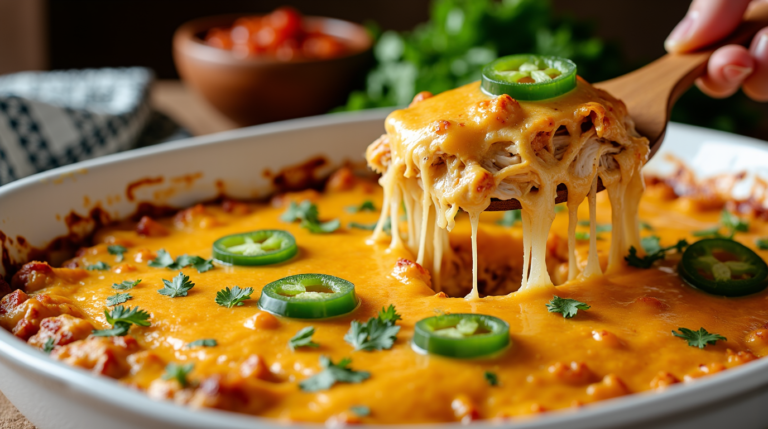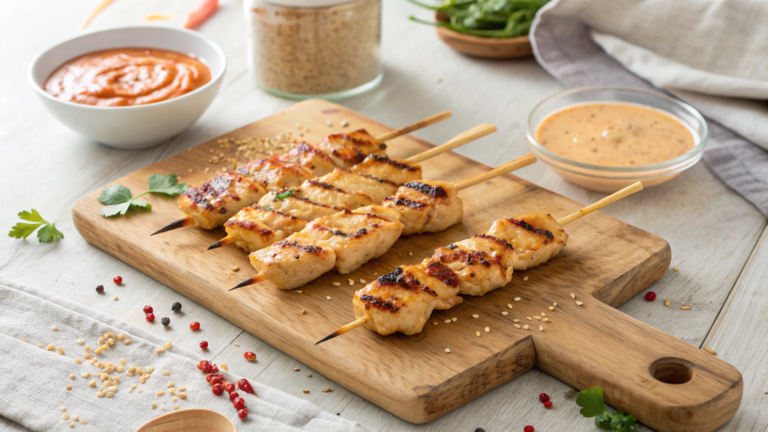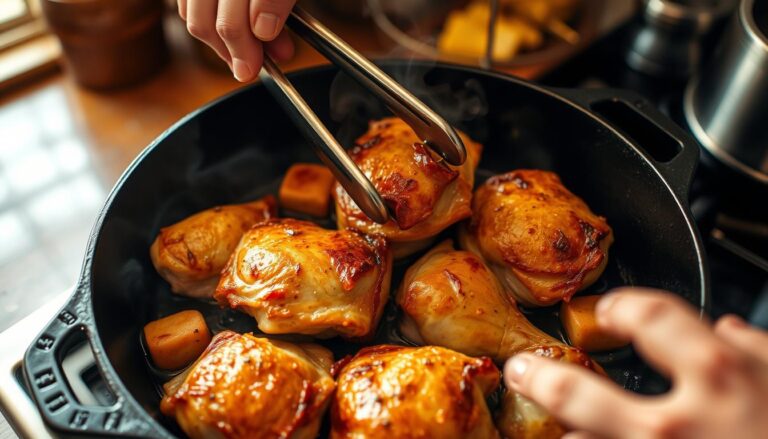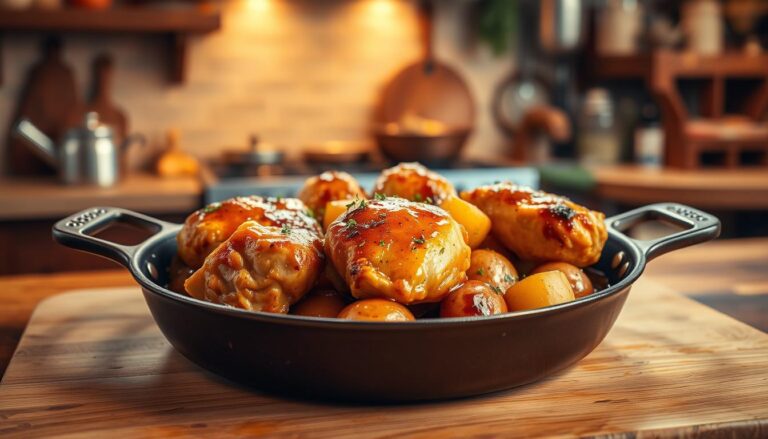How to Make Chicken Crust Pizza: A Low-Carb Favorite

Craving pizza but want to skip the carbs? Chicken crust pizza offers a delicious solution for health-conscious food lovers. This innovative low-carb pizza alternative transforms ground chicken into a crispy, protein-packed base that satisfies your pizza cravings without the traditional wheat flour.
Chicken crust pizza has become a game-changer for people following ketogenic and low-carb diets. By replacing traditional dough with seasoned ground chicken, you create a nutritious and flavorful pizza that delivers all the satisfaction of a classic slice without the extra carbohydrates.
Key Takeaways
- As a substitute for classic pizza, chicken crust offers fewer carbs and more protein.
- Perfect for keto and low-carb diet followers
- Easy to customize with various toppings
- Reduces overall carbohydrate intake
- Quick and simple to prepare at home
Understanding Chicken Crust Pizza
Experience a new take on pizza that turns this beloved comfort food into a healthy and nutritious option. Chicken crust pizza is a game-changing option for those who care about their health and want a delicious low-carb alternative.
What Sets This Pizza Apart
Traditional pizza crusts are typically made with wheat flour, which is high in carbohydrates . Unlike traditional crusts, a keto pizza base made with ground chicken delivers a high-protein alternative with significantly fewer carbs. This innovative approach creates a high-protein pizza that satisfies your cravings without compromising nutritional goals.
- Zero wheat flour
- Primarily protein-based
- Gluten-free alternative
- Supports low-carb dietary needs
Nutritional Advantages
Your body will thank you for choosing a chicken-based pizza crust. The high-protein composition supports muscle maintenance, provides sustained energy, and helps control hunger more effectively than traditional pizza crusts.
Why This Recipe Succeeds
The magic of chicken crust pizza lies in its simple yet brilliant ingredients. Ground chicken, eggs, and cheese create a surprisingly sturdy and delicious base. The eggs act as a natural binding agent, while cheese adds flavor and helps maintain the crust’s structural integrity.
Transform your pizza experience with a protein-rich, low-carb alternative that doesn’t compromise on taste!
Essential Ingredients for the Perfect Crust
Crafting a tasty low-carb pizza crust begins with choosing the right ingredients for a chicken-based base. Your success depends on choosing high-quality components that work together to create a crispy, flavorful crust.
The foundation of your chicken crust pizza requires a few key ingredients:
- Ground chicken (lean and fresh)
- Parmesan cheese
- Large eggs
- Seasonings for extra flavor
When selecting ground chicken, opt for lean meat with minimal fat content. The lower the fat percentage, the crispier your low-carb pizza base will become. Parmesan cheese acts as a binding agent while adding rich, savory notes to your crust.
“The secret to a perfect chicken crust is in the quality of your ingredients” – Professional Pizza Chef
The right seasoning blend can elevate a simple chicken pizza base into a remarkable culinary delight. Consider these flavor-enhancing options:
- Garlic powder
- Dried Italian herbs
- Cracked black pepper
- Sea salt
Keep in mind that using fresh, high-quality ingredients makes all the difference when creating a low-carb pizza base that can wow even the pickiest pizza fans.
Kitchen Tools and Equipment Needed
Preparing a delicious chicken crust pizza requires the right pizza making tools and baking equipment. Having the correct kitchen gear can make your low-carb pizza preparation smooth and enjoyable. Whether you’re just starting out or a seasoned home cook, having the right tools makes all the difference.
Your kitchen arsenal for chicken crust pizza should include several essential items that will help you create a perfect meal from start to finish.
Required Baking Tools
- Baking sheet or rimmed cookie pan
- Parchment paper or silicone baking mat
- Large mixing bowl
- Measuring cups and spoons
- Cheese grater
- Kitchen knife
- Spatula or turner
Optional Equipment for Better Results
- Food processor for blending ingredients
- Stand mixer for consistent mixing
- Meat thermometer
- Pizza stone for crispy crust
- Rolling pin for even crust thickness
Surface Preparation Materials
Proper surface preparation is key to preventing your chicken crust from sticking. It’s worth investing in good parchment paper or a silicone baking mat—they really make the process easier.These baking equipment essentials will ensure easy removal and clean-up after cooking.
Pro tip: Always line your baking sheet with parchment paper or a silicone mat before spreading your chicken crust mixture. This simple step can make a significant difference in your pizza-making experience.
Preparing the Chicken Base
Creating the perfect chicken pizza base starts with choosing high-quality ground chicken.Your ground chicken preparation is crucial to developing a delicious low-carb pizza crust that will impress your taste buds and nutrition goals.
To begin your chicken base for pizza, you’ll need a few key ingredients and techniques to ensure a smooth, well-mixed foundation:
- Choose lean ground chicken with minimal fat content
- Be sure your ingredients are fresh and let them come to room temperature before getting started..
- Use a large mixing bowl for easy blending
The mixing process requires careful attention to detail. Start by combining ground chicken with eggs and grated parmesan cheese. Use a fork or spatula to break up any large chunks of chicken and mix everything evenly.Consistency is key – you want a texture that holds together but isn’t too dense.
Generously season your chicken base with herbs and spices to boost the flavor. Garlic powder, dried oregano, and a pinch of salt can elevate the flavor profile. Mix thoroughly to distribute seasonings evenly throughout the ground chicken preparation.
Pro tip: Drain any excess moisture from the ground chicken to prevent a soggy pizza crust.
Your chicken base should have a slightly sticky consistency that can be easily spread on parchment paper. When you can form the mixture into a thin, even layer without it falling apart, you’ve achieved the perfect preparation for your low-carb pizza crust.
Mixing and Seasoning Techniques
Creating the perfect chicken crust pizza starts with mastering the art of mixing and seasoning. Your chicken crust flavoring can transform an ordinary low-carb pizza into a delectable meal that satisfies your taste buds.
The secret to great pizza seasoning is finding the perfect balance of your ingredients. A standard ratio for a successful chicken crust includes:
- 1 pound ground chicken
- 1/2 cup grated Parmesan cheese
- 1 large egg
Selecting the Right Seasonings
Your chicken crust flavoring should include a blend of herbs and spices that complement the meat’s natural taste. Consider these essential seasonings:
- Garlic powder – adds depth and aromatic flavor
- Italian seasoning – provides a classic pizza profile
- Sea salt – enhances overall taste
- Black pepper – brings subtle heat
Pro Mixing Tips
When combining your ingredients, mix thoroughly but gently. Overmixing can make your chicken crust tough. Use your hands to blend the pizza seasoning evenly, ensuring each bite is packed with flavor.
Experiment with additional herbs like dried basil or oregano to create your unique chicken crust flavoring. Remember, the goal is to craft a pizza crust that’s both nutritious and delicious.
Forming and Shaping Your Chicken Crust Pizza
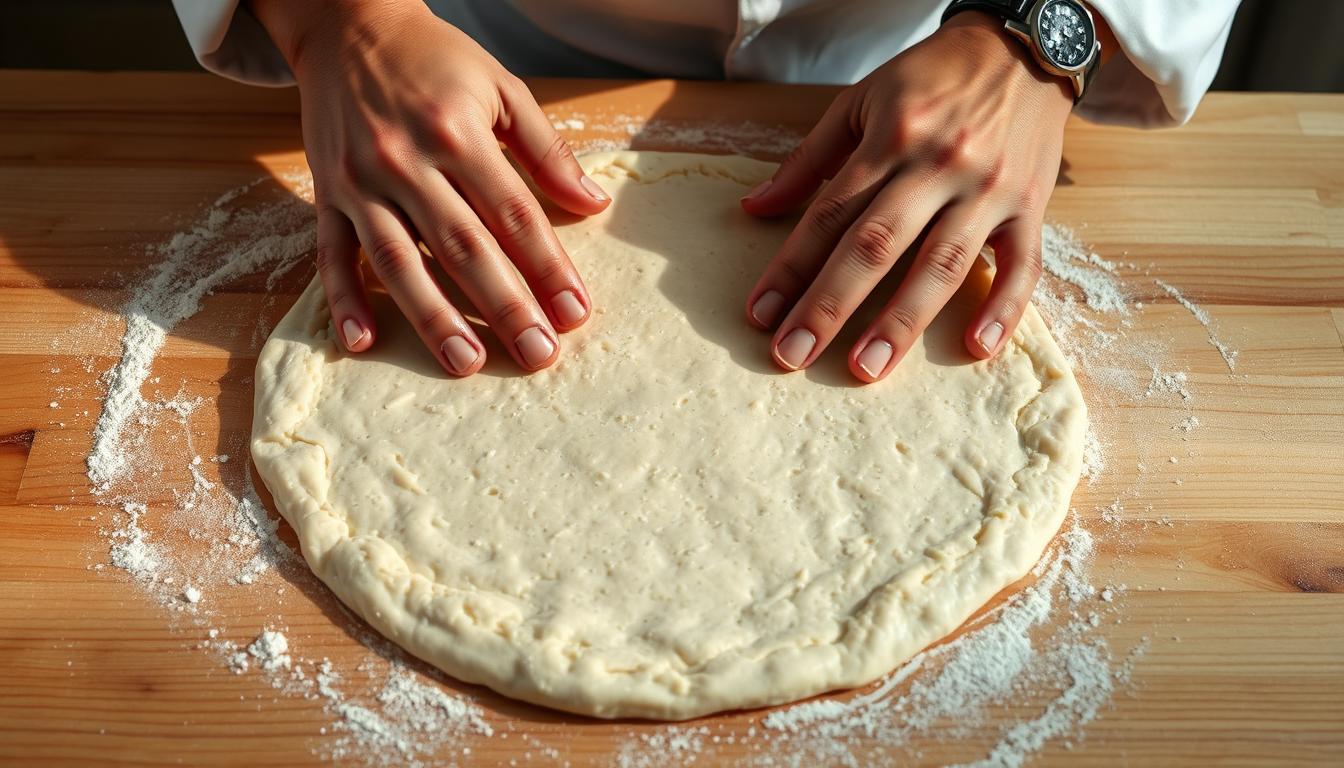
Mastering the art of shaping pizza crust is crucial when creating a delicious chicken pizza base. The right technique can transform your low-carb pizza from ordinary to extraordinary. Start by preparing a smooth, even surface for your chicken mixture.
When shaping your chicken pizza base, follow these key steps:
- Use parchment paper to prevent sticking
- Spread the chicken mixture evenly
- Keep the dough evenly rolled out to about a quarter inch thick all around
- Gently shape raised edges to give it that classic pizza look
Your goal is to create a uniform chicken crust that will support toppings without falling apart.Here’s a quick tip: use the back of a spoon or a spatula to smooth the surface nicely.Gently but firmly press the mixture to make sure the base stays compact and holds together well.
Common shaping mistakes can mess up the base of your chicken pizza.. Avoid these common errors:
- Making the crust too thick, which prevents crispy edges
- Leaving uneven spots that cook differently
- Forgetting to pre-bake the chicken crust
For best results, aim for a circular or rectangular shape depending on your baking sheet. The key is consistency in both shape and thickness when shaping pizza crust.
Baking Temperature and Timing Guidelines
Perfecting baking chicken pizza requires precise temperature control and careful timing. The two-phase baking process ensures a crispy, golden chicken crust that serves as an excellent low-carb pizza base.
Your pizza cooking time will be split into two critical stages to achieve the best results:
Initial Baking Phase
During the first baking stage, you’ll transform your ground chicken mixture into a sturdy crust. Follow these key steps:
- Preheat your oven to 400°F
- Spread chicken mixture evenly on parchment paper
- Bake for approximately 25 minutes
- Look for golden edges and firm texture
Final Baking with Toppings
After creating your initial chicken crust, you’ll add toppings and complete the baking process:
- Increase oven temperature to 425°F
- Add preferred pizza toppings
- Bake for an additional 10 minutes
- Watch for cheese melting and edges browning
Pro tip for baking chicken pizza: Use a pizza stone or preheated baking sheet to enhance crust crispiness during pizza cooking time.
| Baking Stage | Temperature | Duration | Goal |
|---|---|---|---|
| Chicken Crust | 400°F | 25 minutes | Create firm base |
| Topped Pizza | 425°F | 10 minutes | Melt toppings, crisp edges |
Remember that oven temperatures might vary slightly, so monitor your chicken crust pizza closely during baking to prevent overcooking.
Best Topping Combinations
Selecting the right pizza toppings can transform your chicken crust pizza from ordinary to extraordinary. When choosing low-carb pizza toppings, you’ll want to focus on ingredients that complement the unique chicken crust base while keeping your meal nutritious and delicious.
Classic pizza toppings work wonderfully with chicken crust, but you’ll want to be strategic about your selections. The goal is to create a balanced flavor profile that enhances the lean protein base.
- Protein-Rich Toppings:
- Grilled chicken
- Crispy bacon
- Pepperoni
- Prosciutto
- Vegetable Toppings:
- Spinach
- Bell peppers
- Mushrooms
- Artichoke hearts
For cheese lovers, consider low-moisture options that melt beautifully. Mozzarella, goat cheese, and parmesan provide excellent texture and flavor without adding excessive carbohydrates.
| Topping Category | Best Low-Carb Options | Carb Count (per serving) |
|---|---|---|
| Proteins | Grilled chicken, salami | 0-1g |
| Vegetables | Spinach, zucchini, mushrooms | 2-3g |
| Cheeses | Mozzarella, feta, parmesan | 1-2g |
When crafting your pizza toppings, remember that variety is key. Mix different textures and flavors to create a satisfying low-carb pizza experience that doesn’t compromise on taste.
Storage and Reheating Methods
Preserving the delicious taste and texture of your homemade chicken crust pizza requires careful storage and reheating techniques. Storing leftover pizza correctly ensures you can enjoy your meal for several days while maintaining its quality and food safety.
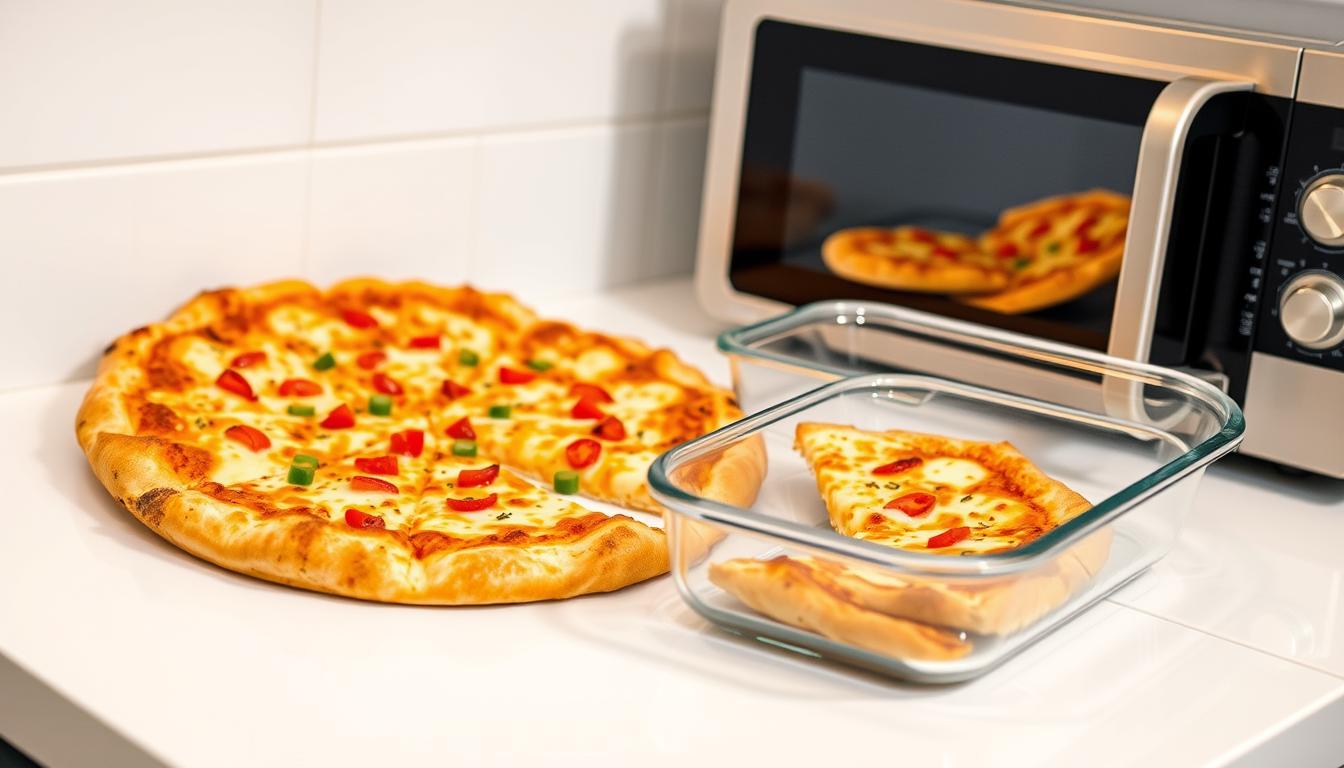
Proper storage is crucial for keeping your chicken pizza fresh and appetizing. Follow these guidelines to maximize the shelf life of your low-carb pizza creation:
Refrigeration Tips
- Allow the pizza to cool completely before storing
- Store it in an airtight container or wrap it tightly with plastic wrap.
- Store in the refrigerator for up to 4 days
- Place a paper towel between pizza slices to absorb moisture
Freezing Instructions
Reheating chicken pizza from frozen requires special attention to maintain its texture and flavor:
- Wrap individual slices in freezer-safe plastic wrap
- Place wrapped slices in a freezer-safe container
- Freeze for up to 2 months
- Thaw in the refrigerator overnight before reheating
Proper Reheating Techniques
To keep the chicken crust nice and crispy, skip the microwave when reheating. Instead, use these methods:
- Oven Method: Preheat to 375°F and bake for 8-10 minutes
- Air Fryer Method: Heat at 350°F for 3-4 minutes
- Add a small drizzle of olive oil on top to keep it from drying out.
By following these storing leftover pizza and reheating chicken pizza techniques, you’ll ensure your low-carb pizza remains delicious and safe to eat.
Troubleshooting Common Issues
Creating the perfect chicken pizza crust can be challenging. Many home cooks encounter specific issues that can make or break their low-carb pizza experience. Understanding how to address these chicken pizza problems will help you master the art of fixing pizza crust.
Most Common Crust Challenges
- Soggy Crust: The most frequent issue with chicken crust pizzas
- Uneven cooking surfaces
- Toppings sliding off the base
- Excess moisture compromising texture
Moisture removal is critical when preparing your chicken base. Pat the ground chicken well with paper towels to soak up any excess moisture.This step keeps the base from turning soggy and gives you a firm, crispy crust.
| Problem | Solution | Recommended Technique |
|---|---|---|
| Excess Moisture | Remove water from chicken | Use cheesecloth or multiple paper towels |
| Weak Crust Structure | Add binding ingredients | Mix in egg and cheese |
| Uneven Baking | Adjust oven rack position | Use middle rack, rotate halfway |
When fixing pizza crust, consider using parchment paper for easier removal and more consistent cooking. Spread the chicken mixture evenly, creating a thin, uniform base that will crisp up nicely in the oven.
Pro tip: Pre-bake your chicken crust for 10-15 minutes before adding toppings to create a stable, crispy foundation.
By implementing these strategies, you’ll overcome typical chicken pizza problems and create a delicious, low-carb alternative that satisfies your pizza cravings.
Nutritional Information and Health Benefits
Chicken pizza brings a refreshing nutritional twist to the classic version.. Your low-carb pizza benefits extend far beyond typical meal options, providing a protein-packed dish that supports your health goals.
A typical slice of chicken crust pizza delivers an impressive nutritional profile:
- Protein: 30-40 grams per slice
- Net Carbs: Only 5-7 grams
- Calories: Approximately 300-400 per slice
The chicken crust completely reimagines pizza, turning it into a high-protein, low-fat option.Your body receives essential nutrients while enjoying a familiar comfort food.
| Nutrient | Chicken Crust Pizza | Traditional Pizza |
|---|---|---|
| Protein | 30-40g | 10-15g |
| Carbohydrates | 5-7g | 30-40g |
| Calories | 300-400 | 500-600 |
Low-carb pizza benefits include improved blood sugar management and potential weight loss support. The high protein content helps maintain muscle mass while reducing overall calorie intake.
Individuals following ketogenic, paleo, or low-carb diets will find chicken crust pizza an excellent meal option. Your nutritional goals no longer mean sacrificing flavor.
Conclusion
Making a tasty low-carb pizza doesn’t need to be tricky or complicated.Your homemade chicken pizza offers a nutritious and exciting alternative to traditional pizza crusts. By mastering the techniques outlined in this guide, you’ve unlocked a world of culinary possibilities that support your health and taste preferences.
The versatility of this low-carb pizza recipe means you can experiment with different seasonings, toppings, and cooking methods. Whether you’re following a ketogenic diet or simply looking to reduce carbohydrate intake, chicken crust pizza provides a protein-packed meal that satisfies your pizza cravings without compromising on flavor.
As you continue to refine your skills, remember that practice makes perfect. Each time you prepare this homemade chicken pizza, you’ll gain more confidence in your cooking abilities. Don’t be afraid to get creative and personalize your pizza with unique ingredient combinations that reflect your taste and nutritional goals.
We invite you to share your chicken crust pizza experiences, recipe modifications, and culinary discoveries. Your kitchen adventures can inspire others to explore this delicious and health-conscious approach to enjoying pizza.
FAQ
What is chicken crust pizza?
Chicken crust pizza is a low-carb alternative to traditional pizza, where ground chicken replaces the traditional wheat flour crust. It’s an innovative option for those following keto, low-carb, or gluten-free diets, providing a high-protein base that can be topped with your favorite pizza ingredients.
Is chicken crust pizza healthier than regular pizza?
Yes, chicken crust pizza is typically healthier. It’s lower in carbohydrates, higher in protein, and eliminates wheat flour. This makes it an excellent option for weight management, blood sugar control, and those looking to reduce their carbohydrate intake while still enjoying pizza flavors.
Can I freeze chicken crust pizza?
Absolutely! You can freeze chicken crust pizza before or after adding toppings. For best results, wrap it tightly in plastic wrap and aluminum foil. When ready to eat, thaw in the refrigerator and reheat in the oven to maintain the crust’s crispy texture.
What binding ingredients make the chicken crust work?
Eggs and cheese are crucial binding ingredients. They help hold the ground chicken together, create structure, and provide the necessary cohesion to form a sturdy pizza-like base that can support toppings without falling apart.
How do I prevent my chicken crust from becoming soggy?
To prevent a soggy crust, pre-bake the chicken base until it’s firm and golden, remove excess moisture from the ground chicken, and avoid using watery toppings. Using a parchment-lined baking sheet and ensuring the crust is well-dried before adding toppings can help maintain a crispy texture.
What type of ground chicken works best?
Lean ground chicken with about 93% lean meat works best. It provides enough protein while minimizing excess moisture. Avoid ground chicken with high fat content, as this can make your crust too wet and less likely to crisp up properly.
Can I make chicken crust pizza if I’m on a keto diet?
Yes, chicken crust pizza is an ideal option for those on a keto diet. It’s extremely low in carbohydrates, high in protein, and can be customized with keto-friendly toppings like cheese, low-carb vegetables, and meats.
How long does chicken crust pizza take to prepare?
The total preparation time is typically around 30-40 minutes, including mixing the crust, pre-baking, adding toppings, and final baking. The actual hands-on time is usually about 15-20 minutes.
Can I make the chicken crust ahead of time?
Yes, you can prepare the chicken crust in advance. After pre-baking, let it cool completely, then store it in the refrigerator for 1-2 days or freeze for up to a month. When ready to eat, add toppings and finish baking.
Are there vegetarian alternatives to chicken crust?
While traditional chicken crust isn’t vegetarian, you can experiment with alternatives like ground turkey, cauliflower, or plant-based protein crumbles. However, these may require different binding techniques and ingredient ratios.

